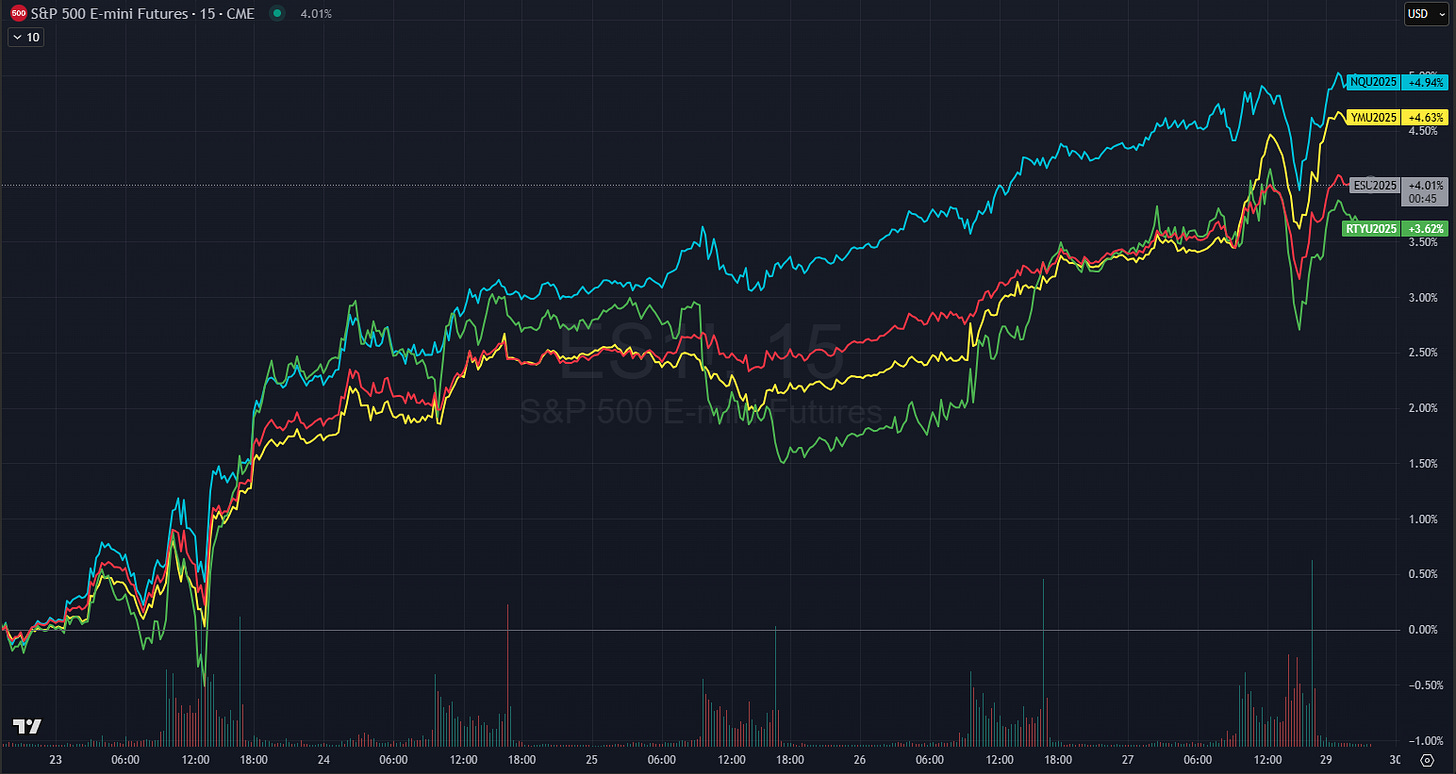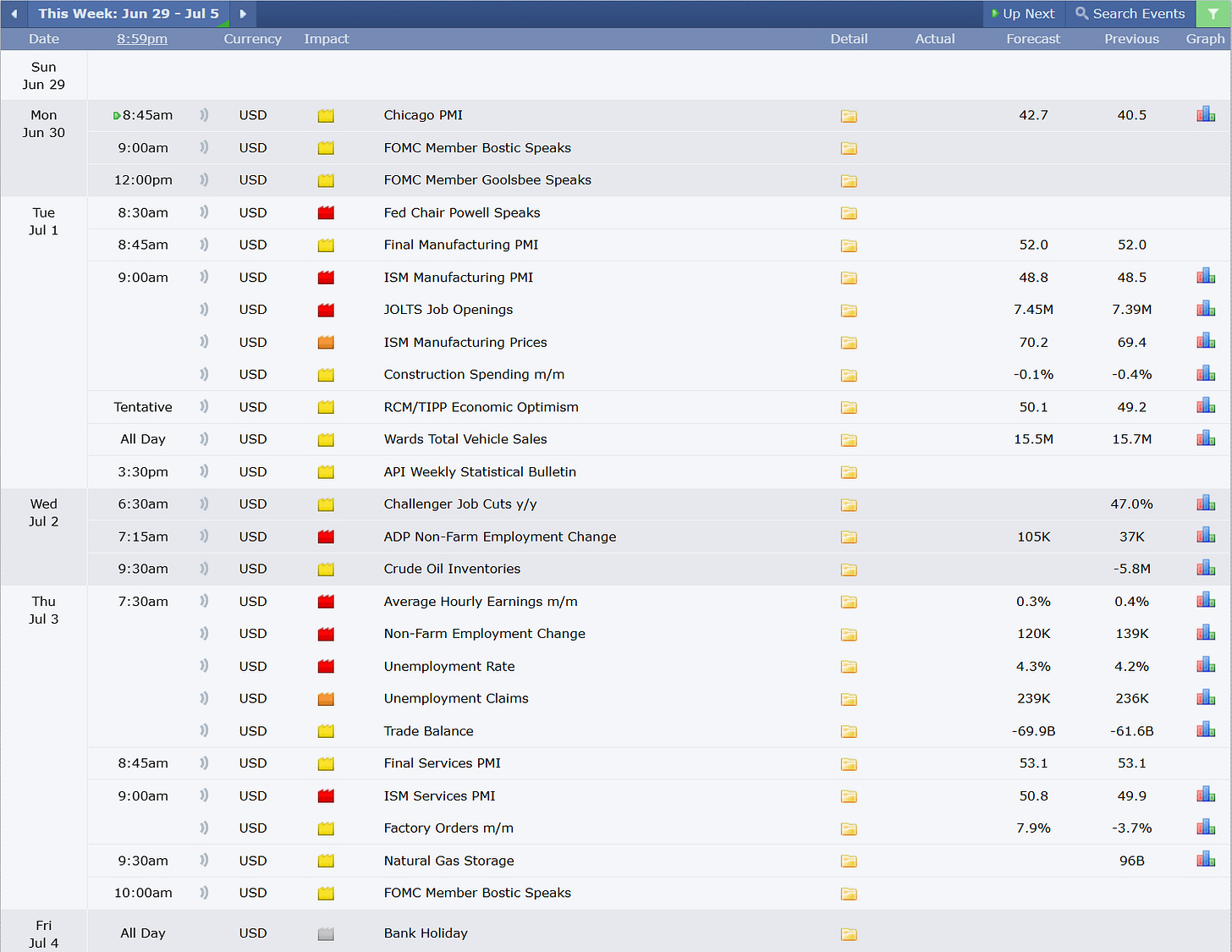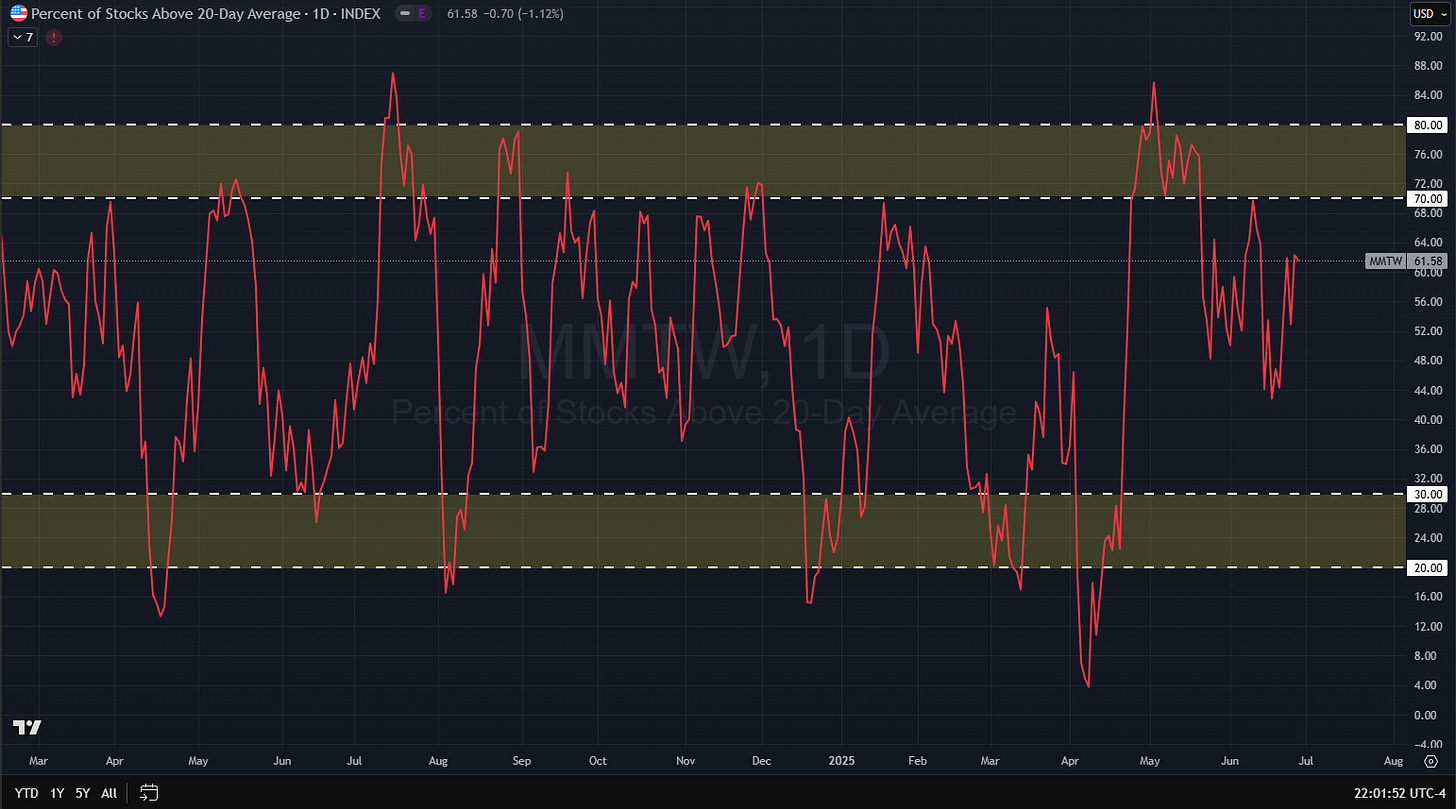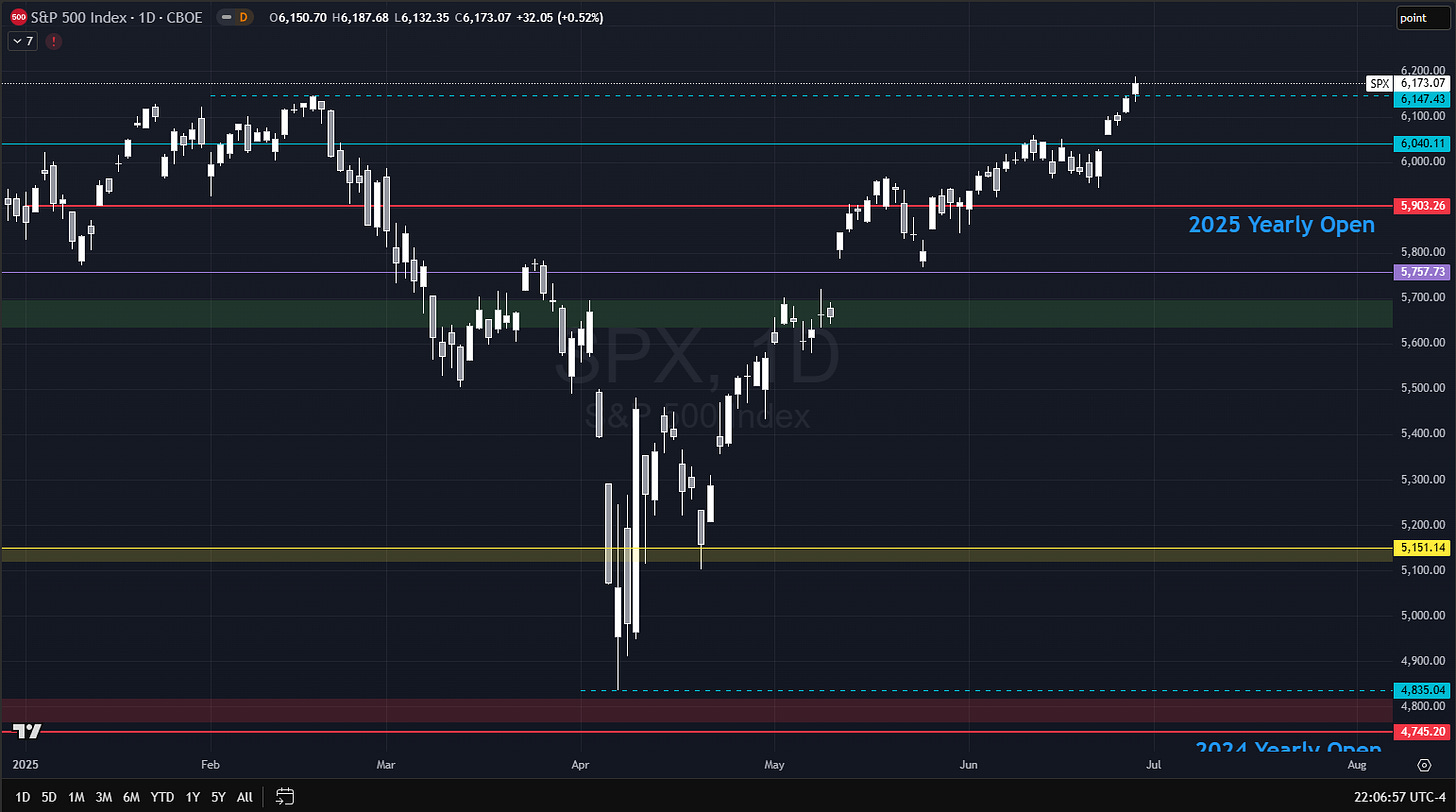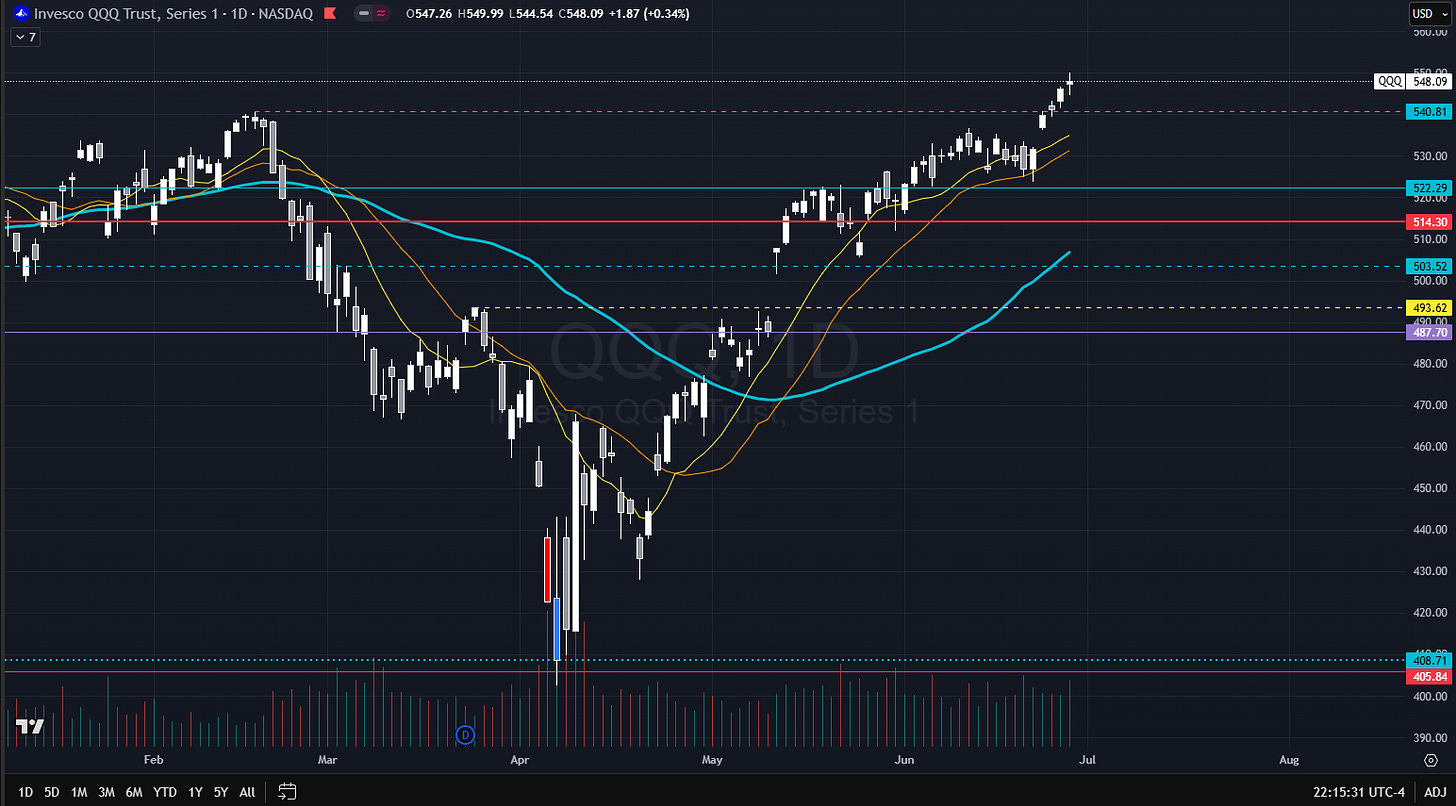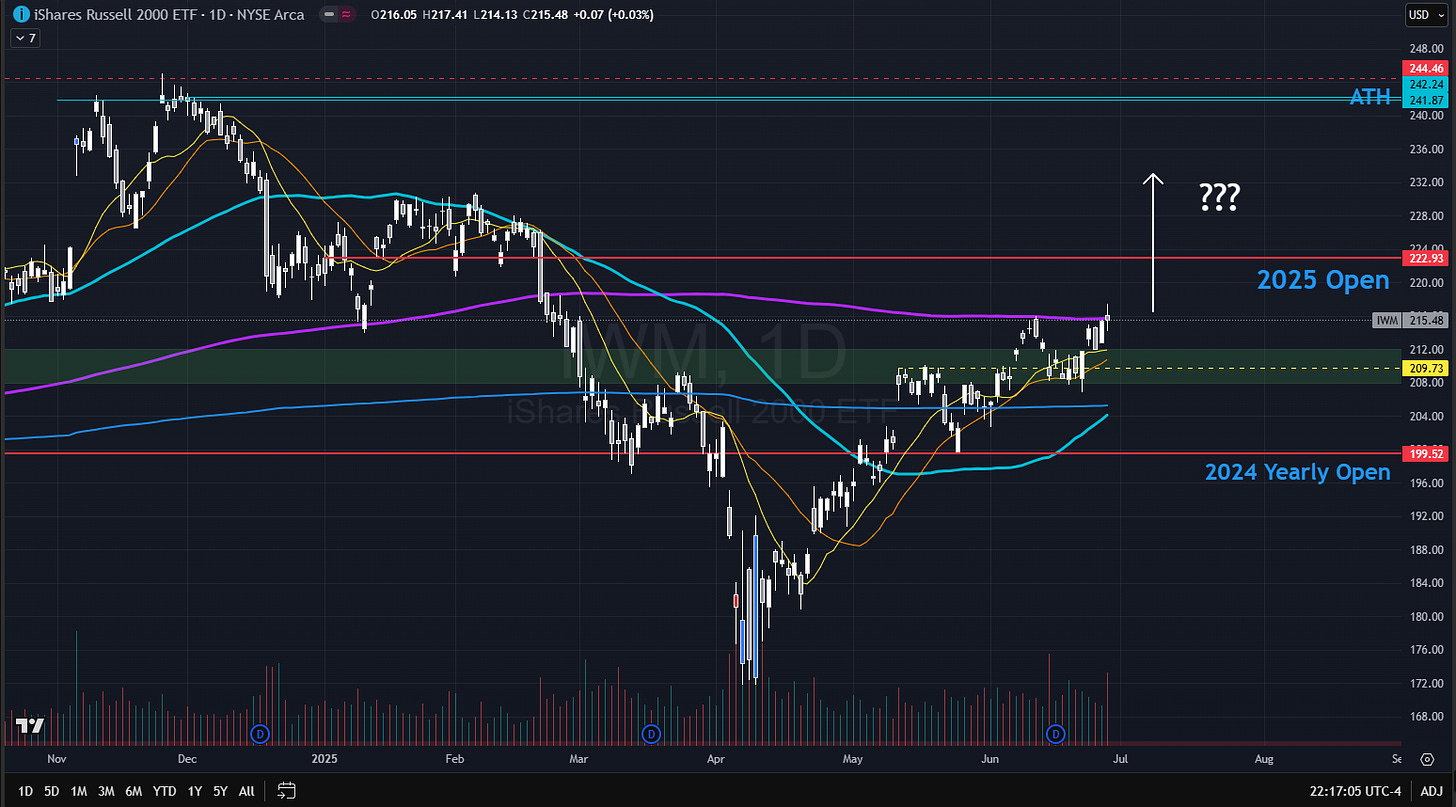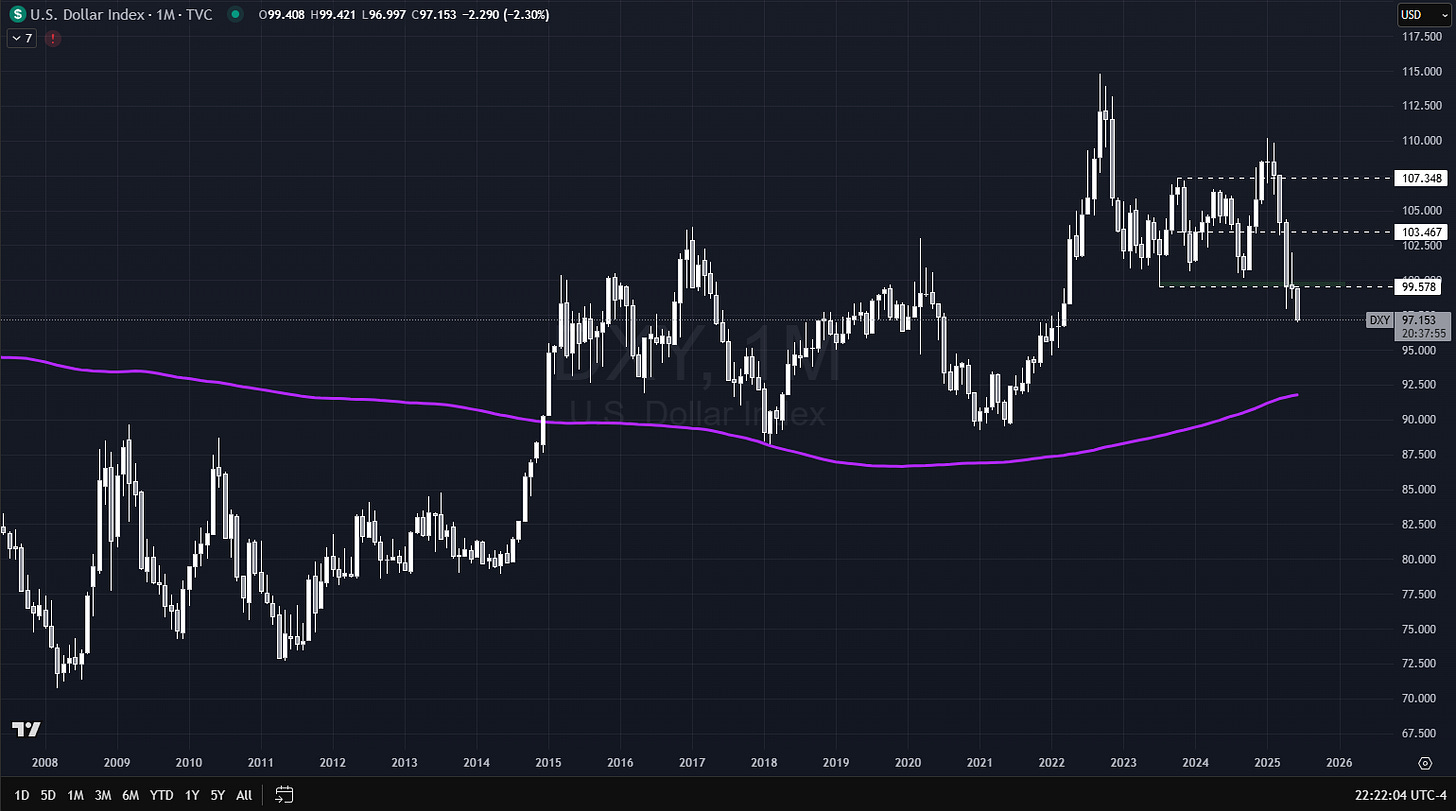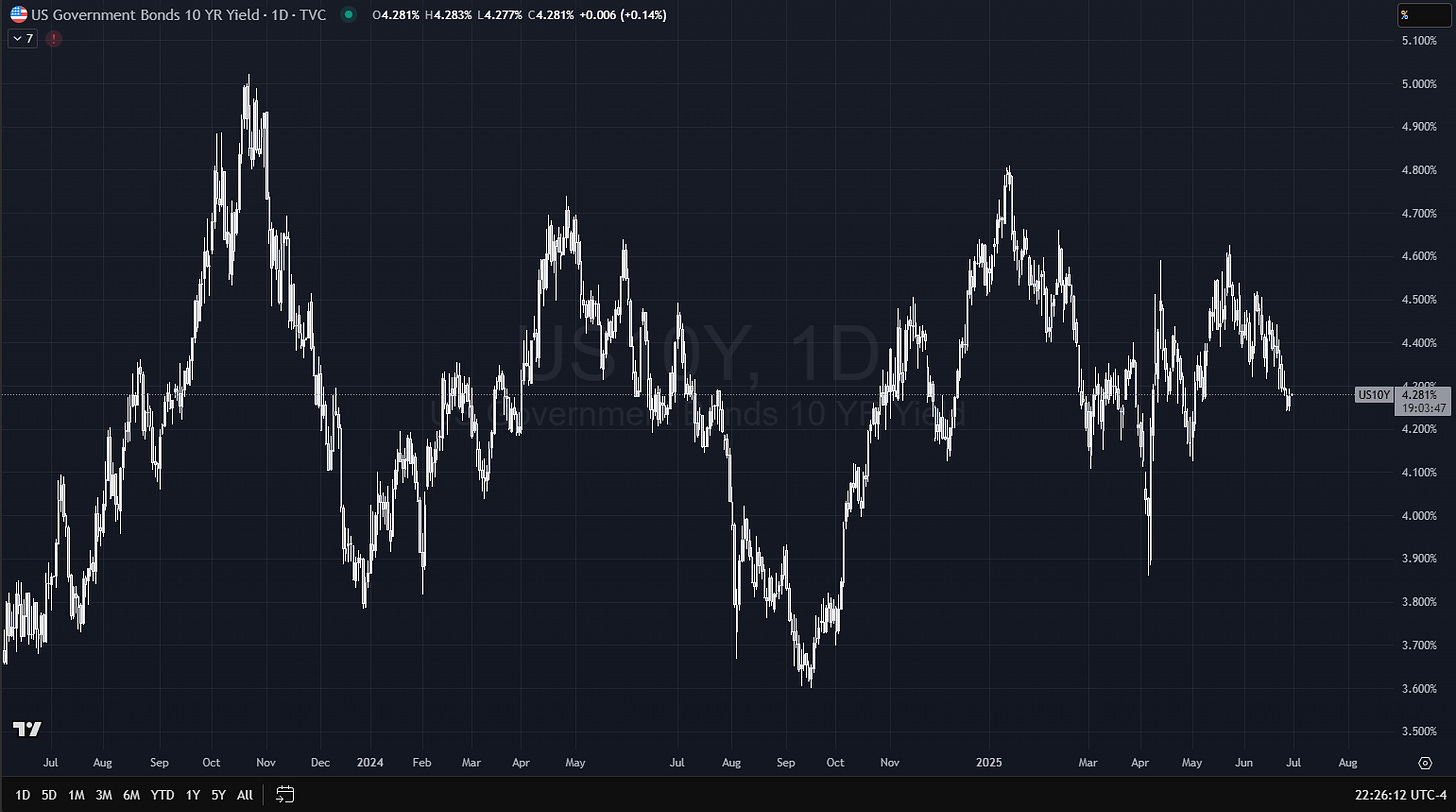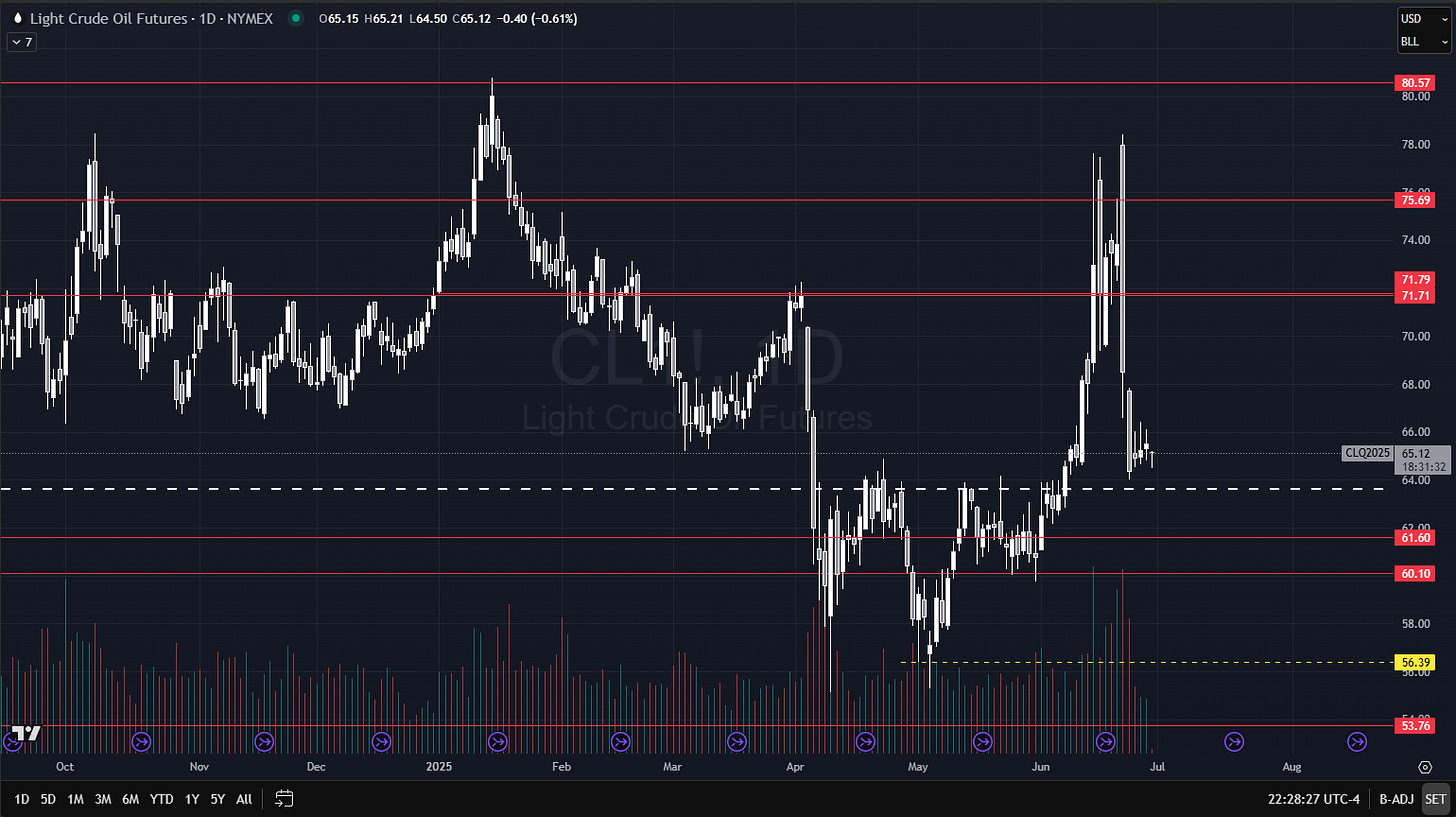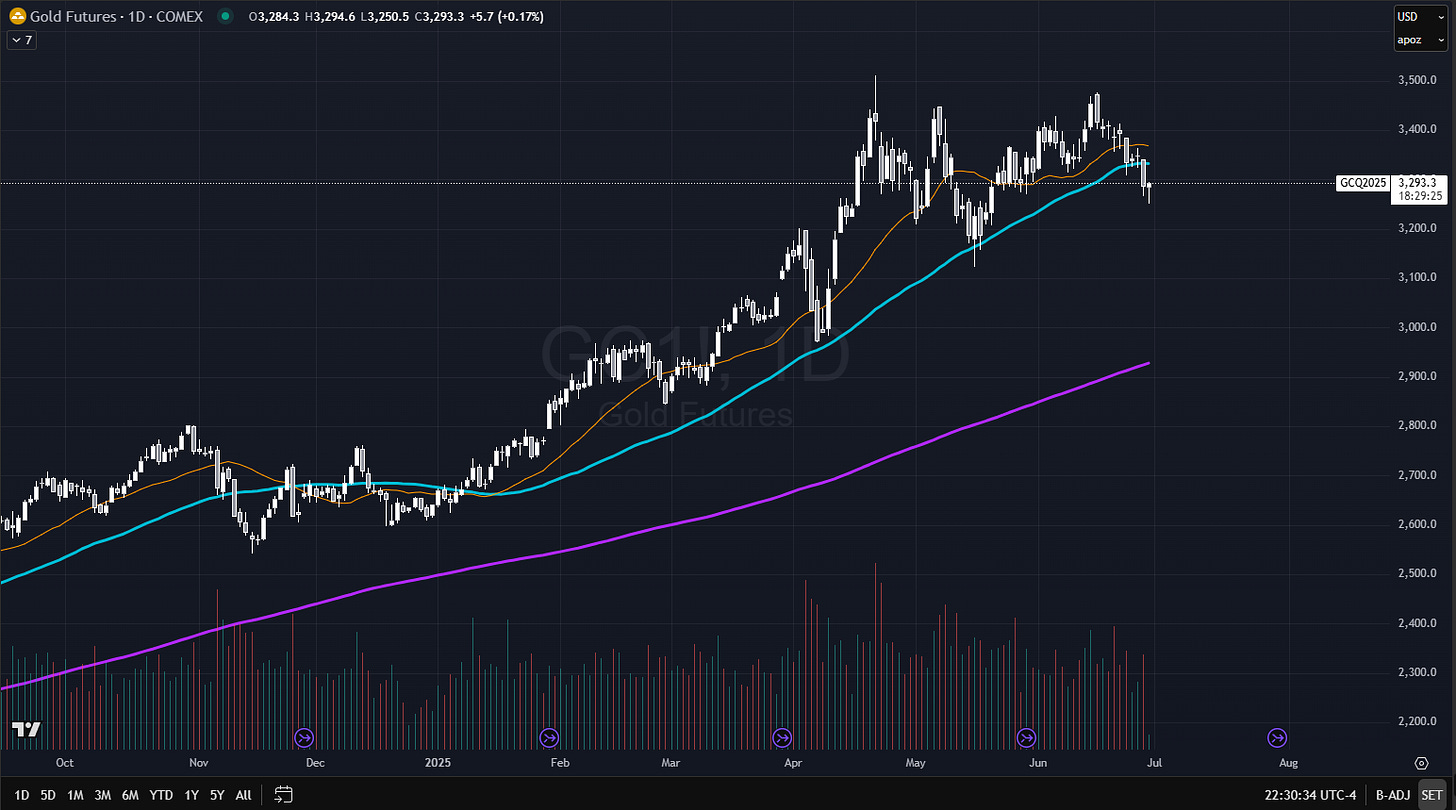War Games, Rate Games, and the Big Beautiful Melt-Up
Weekly Roadmap for 06/29-07/05
Housekeeping
Before we jump in, a quick note: last week we published a timely macro update (link below) where we pointed out that Trump, after responding to the Iran situation, was likely running low on political capital.
We suggested he might seek concessions to steady the ship, most likely on trade talks with China or pushing forward the Big Beautiful Bill (BBB). Sure enough, just days later, the administration announced a trade deal with China.
Market Recap
It was an eventful week for stocks. The week started with anxiety and headline-driven fear as the U.S. joined an attack on Iran, pushing markets lower early on. Then came Iran’s retaliation, which appeared more like a save-face move than true escalation, marking the low for the week. Afterward, attention shifted to the Fed, where Waller and Bowman hinted at a possible July rate cut. Trump’s suggestion of replacing Powell with someone more dovish only added to rate-cut enthusiasm.
In response, stocks and bonds rallied, while the dollar sank to new lows. The S&P 500 and Nasdaq both notched fresh all-time highs, with the Nasdaq leading the week higher by 4.22%. Small caps lagged but still managed a respectable 2.87% gain.
Looking Ahead
This coming week will be shortened by the holiday, with an early market close Thursday and a full closure Friday. Despite the shortened schedule, there’s plenty on the calendar:
Labor market data will be in focus, including Thursday’s Non-Farm Payrolls report
Eyes will also be on whether the administration’s BBB legislation can be pushed through by July 4
SPX Check-In
The SPX closed at a new all-time high last week, driven by easing geopolitical tensions, dovish Fed commentary, and Trump’s positioning on the future of the Fed chair. The rally was healthy, with strong signs that the gains have been broadly supported, not just a few names carrying the weight.
Another point to note: only about 61% of stocks are above their 20-day moving averages, meaning the market is neither overheated nor stretched, even after this breakout. Given that the indices had traded sideways for nearly two months, this breakout looks robust rather than fragile.
July Technicals
On the technical side, the SPX has posted five bullish gaps since bottoming in early April, and none of those gaps have been filled. That strength was confirmed again last Tuesday with another bull gap.
Levels to watch:
As long as SPX stays above our highest monthly close of 6040, bulls have the advantage and most likely target 6300 next.
If that zone breaks, the next defense will be our yearly open around 5900.
QQQ
The Nasdaq 100 (QQQ) was the clear leader last week, closing up 4.22%. A key driver was a fresh bull-gap that opened after headlines of a ceasefire between Israel and Iran. As we’ve noted before, when bull-gaps aren’t quickly filled, the market tends to trend in the same direction and that’s exactly what played out…
Looking ahead, if QQQ can stay above that bull-gap area around 535, bulls should keep the advantage into the beginning of this month, with upside potential toward 557. July, after all, has historically been a strong seasonal month for the index. A continued breakout would also likely ride on the back of semiconductor strength.
IWM (Small Caps)
Small caps lagged the broader market last week, though still posted a respectable 2.87% gain. Conditions look promising heading into July, with a “goldilocks” setup possible:
Plenty of dovish signals from the Fed
Strong hard-data readings
Inflation data remains generally contained
If these tailwinds persist, small caps could break out further, particularly with deregulation measures expected to kick in during the second half of the year. Positioning in small caps remains historically light, so a strong move above the 200-day moving average could spark a “pain trade” rally higher.
The Dollar
A theme we’ve been tracking is that the dollar remains at a critical juncture. Right now, the dollar index appears to have undergone a decisive break through the 100 level, a support that held for over 3 years… because of this a sharper flush lower toward the 200-month moving average around the 92 level looks likely.
Last week was especially interesting for the dollar. As tensions rose between Israel and Iran, the U.S. joined an attack targeting uranium enrichment facilities. That effectively removed near-term left-tail geopolitical risks, sending oil prices sharply lower by $12/bbl off the highs and deflating a minor “war bid” in the dollar.
Even though oil had rallied over 40% off April lows, the dollar barely budged only managing a 2-handle move off the lows. That stands out, because the last time oil was trading at these levels near $77.50–$80/bbl, the dollar index (DXY) was up at 110. This time, however, the dollar even made fresh local lows, showing how weak the bid truly is.
On top of that, more pressure came from Washington:
Trump confirmed he wants to replace Powell with a Fed chair who is explicitly dovish and supports rate cuts.
Trump even stated he thinks 1% interest is appropriate at present.
The administration also signaled it might use the same playbook as Yellen (extending short-term debt) despite earlier promises not to.
All of this adds up to a further challenge for the dollar’s credibility, weakening confidence in the Fed’s independence and encouraging financial conditions to keep easing, which weighs on the dollar.
Positioning is another factor worth noting: the dollar is the most underweighted it has been in over 20 years. But, as always, underweight positioning alone is not enough to spark a rally, there needs to be a clear catalyst to force an unwind. The failed bounce during Middle East tensions underlines that a bigger catalyst will be needed to reverse the dollar’s downtrend.
Bottom line: the dollar made new local lows last week and continues to look vulnerable to a breakdown toward the low 90s, with a key support target near 92 on the 200-month.
Bonds
Bonds continued to find relief last week as well, following the same easing of Middle East tensions and on the back of Trump’s dovish Fed comments. That narrative of extending short-term debt and picking a pro-cut Fed chair further supported bonds, which saw the 10-year Treasury yield break below 4.35%.
Key levels to watch on the 10Y:
For a deeper bond rally, the 10-year yield would need to fall firmly below 4.2%
Otherwise, bonds may stay trapped in the familiar range:
Low end: 4.15%
High end: 4.7%
In the bigger picture, bonds have been rangebound for nearly three years now, and the best trades have been to fade extremes.
Looking Ahead
It will be a holiday-shortened week, with markets closing early on Thursday and fully closed on Friday. Still, there are important events on deck:
Non-Farm Payrolls (NFP) Thursday
Expectations: 129,000 jobs (vs. 139,000 prior)
Unemployment rate steady at 4.2%
Labor supply may stay tight given Trump’s mixed messaging on immigration, but that could keep the unemployment rate anchored
Big Beautiful Bill (BBB)
The administration hopes to pass it by July 4
Trade Deals
The previous trade-deal deadline is about to expire
Bessent now says trade deals could stretch to Labor Day
The administration is pushing the narrative that once BBB is passed, focus will shift to trade
Trump also made a notable comment last week:
“Bitcoin takes a lot of pressure off the dollar, and it’s a great thing for our country.”
This hints again at how the administration is willing to embrace anything that might ease dollar pressures.
In summary, the path of least resistance for the dollar still looks lower unless a powerful catalyst appears, while bonds will likely continue to chop within their long-established ranges unless data or policy surprises shift the narrative.
Oil
Over the weekend, the U.S. followed through on threats to attack Iran’s nuclear sites, essentially ending the “two-week window” Trump had offered Iran to reach a deal. There was no further escalation from Iran, and a ceasefire between Israel and Iran was declared. That de-escalation triggered a sharp unwind in crude, pulling prices down from the highs.
Zooming in:
Crude struggled near $77.50, and as long as that level capped prices, we expected downside to emerge absent a major escalation.
That played out almost perfectly, with crude retracing back to around $65 per barrel, currently sitting below nearly all its key moving averages.
You could argue this is simply a backtest but for meaningful upside to reemerge, two things likely need to happen:
Renewed Middle East tensions
Crude reclaiming $71.80
Gold
Gold also saw a classic “war bid” fade as Middle East tensions cooled. The U.S. attack on Iran essentially ended immediate conflict risk, and as the week progressed, gold’s safe-haven premium unwound. Part of the late-week selling may have been driven by quarter-end positioning as well, plus continued Chinese demand shifting toward platinum instead of gold.
Another layer to gold’s setup is Trump’s continued public criticism of Powell. If Trump replaces Powell with a more dovish chair, as seems likely, it would further undermine Fed independence and encourage investors to hedge against currency debasement with gold. Structurally, that keeps a long-term bull case intact.
Short-term technicals:
Gold broke below both its 21-day and 50-day moving averages last week
It finished the week resting right on a trendline that has supported prices since late 2024
If that support fails, gold could slip toward the 200-day near 3000, which also lines up with the April lows
However, dips are still likely to be bought, given persistent structural tailwinds (a dovish Fed, deficit spending, and ongoing concerns about long-term currency stability).
Wrapping Up
With the second half of the year kicking off, here are the key themes to keep on your radar:
✅ Easing geopolitical tensions have temporarily lifted market sentiment, though risks remain if new flare-ups emerge.
✅ Central bank policy remains the dominant force, with Trump’s push to install a dovish Fed chair likely to shape rate expectations and, by extension, the dollar, bonds, and gold.
✅ Labor data will be critical this week, with NFP expected to moderate but still show a resilient jobs market.
✅ Equity flows and seasonality: July’s strong historical performance and record systematic buy flows could continue to fuel breakouts, particularly in tech and small caps.
✅ Commodities: Crude is resetting after the geopolitical unwind, and gold remains structurally supported even if near-term pressures appear.
As always, stay flexible, stay informed, and stay focused on the bigger picture rather than the daily noise. Markets are still driven by a complex balance of macro tailwinds, geopolitical surprises, and investor positioning, all of which create opportunities if you’re prepared.
Thanks for reading this week’s roadmap.
Stay sharp and get ready for what July has in store.
-BSR
Disclaimer:
Remember, this is not financial advice. You are fully responsible for your own decisions!
The information provided on this website/Substack is for informational purposes only. While it is believed to be reliable, Blackshore Research does not guarantee its completeness or accuracy. This content is not an offer or solicitation to buy any financial instrument. The information and terms on these pages can change without notice. Unauthorized use of Blackshore Research’s websites and systems is strictly prohibited. This includes data scraping, unauthorized access, password misuse, or improper use of posted information. Your eligibility for certain services will be determined by Blackshore Research and its affiliates. Investment services are not FDIC-insured and carry investment risks, including potential loss of principal. The proprietary information from Blackshore Research or third-party providers is for individual use only and must not be redistributed or transferred without prior written consent from Blackshore Research.



